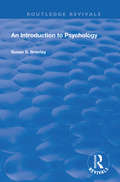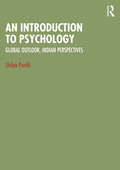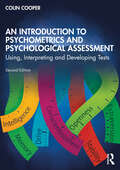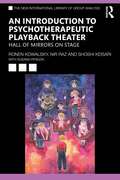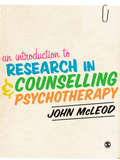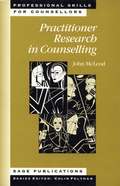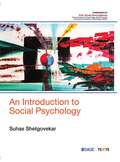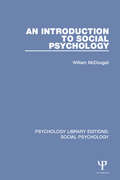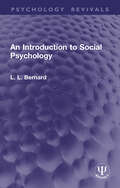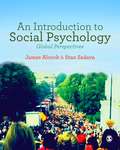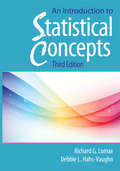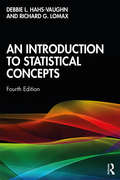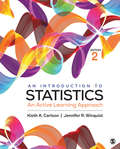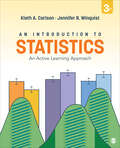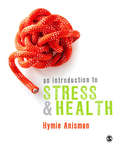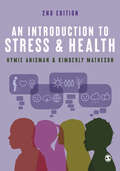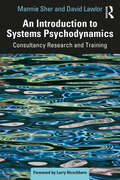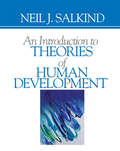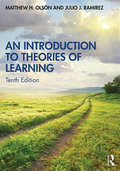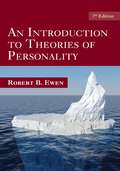- Table View
- List View
An Introduction to Psychology (Routledge Revivals)
by Susan S. BrierleyOriginally published in 1921, this introduction to psychology includes chapters on the definitions and methods related to psychology; organism and environnment; and instinct and intelligence.
An Introduction to Psychology: Global Outlook, Indian Perspectives
by Shilpa PanditThis textbook provides an essential, contextually sensitive and culturally relevant grounding in Psychology that sets the base for future studies. Replete with discussions on current themes and debates in the discipline, its interdisciplinary linkages are relevant in the current times in terms of their contributions and application.This volume addresses the overarching questions of the discipline, with chapters organised to discuss psychological concepts, theories and principles in the light of cultural world views, where culture and the psyche are interdependent. It discusses the indigenous views of self and consciousness as well as contemporary applications of psychology in the global world.This book, designed for a global readership, would be useful to the students and teachers of Psychology, Applied Psychology, and Sociology, and Social Work, Public Health, Gender and Women Studies.
An Introduction to Psychometrics and Psychological Assessment: Using, Interpreting and Developing Tests
by Colin CooperAn Introduction to Psychometrics and Psychological Assessment is the successor to Cooper’s prize-winning book Psychological Testing: Theory and Practice. This expanded and updated volume shows how psychological questionnaires and tests can be chosen, administered, scored, interpreted and developed. In providing students, researchers, test users, test developers and practitioners in the social sciences, education and health with an evaluative guide to choosing, using, interpreting and developing tests, it provides readers a thorough grasp of the principles (and limitations) of testing, together with the necessary methodological detail. This book has three distinctive features. First, it stresses the basic logic of psychological assessment without getting bogged down with mathematics; the spreadsheet simulations and utilities which are integrated into the text allow users to explore how numbers behave, rather than reading equations. Readers will "learn by doing". Second, it covers both the theory behind psychological assessment and the practicalities of locating, designing and using tests and interpreting their scores. Finally, it is evaluative. Rather than just describing concepts such as test reliability or adaptive testing, it stresses the underlying principles, merits and drawbacks of each approach to assessment, and methods of developing and evaluating questionnaires and tests. Unusually for an introductory text, it includes coverage of several cutting-edge techniques, and this new edition expands the discussion on measurement invariance, methods of detecting/quantifying bias and hierarchical factor models, and features added sections on: - Best practices for translation of tests into other languages and problems of cultural bias - Automatic item generation - The advantages, drawbacks and practicalities of internet-based testing - Generalizability theory - Network analysis - Dangerous assumptions made when scoring tests - The accuracy of tests used for assessing individuals - The two-way relationship between psychometrics and psychological theory. Aimed at non-mathematicians, this friendly and engaging text will help you to understand the fundamental principles of psychometrics that underpin the measurement of any human characteristic using any psychological test. Written by a leading figure in the field and accompanied by additional resources, including a set of spreadsheets which use simulated data and other techniques to illustrate important issues, this is an essential introduction for all students of psychology and related disciplines. It assumes very little statistical background and is written for students studying psychological assessment or psychometrics, and for researchers and practitioners who use questionnaires and tests to measure personality, cognitive abilities, educational attainment, mood or motivation.
An Introduction to Psychotherapeutic Playback Theater: Hall of Mirrors on Stage (The New International Library of Group Analysis)
by Ronen Kowalsky Nir Raz Shoshi KeisariAn Introduction to Psychotherapeutic Playback Theater is a comprehensive book presenting Psychotherapeutic Playback Theater as a unique form of group psychotherapy. This pioneering book is the first of its kind, examining this new approach, the theory behind it, and the numerous considerations and diverse possibilities involved in using the technique to promote a significant reflective process among participants. Informed by years of Psychotherapeutic Playback Theater practice and research, the authors detail a collective-creative method that allows for the creation of a therapeutic experience centered on feelings of belonging, acceptance, visibility and liberation. It is presented to the reader as a path toward their development and growth as a conductor working in this newly evolving field of group therapy. The book will be of great interest to dramatherapy students, trainees and professionals, and group therapists who wish to reflect upon their practice through the mirror of Psychotherapeutic Playback Theater as well as facilitators and actors working with Playback Theater or other improvised genres.
An Introduction to Research in Counselling and Psychotherapy
by John McLeodIntroducing the basic principles of research theory and practice, this book is the ideal starter text for any counselling trainee or practitioner learning about the research process for the first time. Structured around common training topics, the book: - Explains why you need to do research at all: what it is, why it's important and its historical and philosophical context - Guides you through the confusing mass of research literature - Covers the ins and outs of actually doing research: practical and ethical issues - Helps you get the most out of research - how to evaluate the outcomes and use research to investigate the process of therapy. Written in a language familiar to first-year trainees and using a range of features to enhance learning, this accessible introduction will equip both trainees and qualified therapists with the essential nuts and bolts to understand research. John McLeod is Emeritus Professor of Counselling at the University of Abertay Dundee and adjunct Professor at the University of Oslo, Norway.
An Introduction to Research in Counselling and Psychotherapy (Professional Skills for Counsellors Series)
by John McleodIntroducing the basic principles of research theory and practice, this book is the ideal starter text for any counselling trainee or practitioner learning about the research process for the first time. Structured around common training topics, the book: - Explains why you need to do research at all: what it is, why it's important and its historical and philosophical context - Guides you through the confusing mass of research literature - Covers the ins and outs of actually doing research: practical and ethical issues - Helps you get the most out of research - how to evaluate the outcomes and use research to investigate the process of therapy. Written in a language familiar to first-year trainees and using a range of features to enhance learning, this accessible introduction will equip both trainees and qualified therapists with the essential nuts and bolts to understand research. John McLeod is Emeritus Professor of Counselling at the University of Abertay Dundee and adjunct Professor at the University of Oslo, Norway.
An Introduction to Social Psychology
by Suhas ShetgovekarThis textbook will help students of psychology and related disciplines to understand the fundamentals of social psychology and its application in the Indian context An Introduction to Social Psychology offers a thorough understanding of all basic concepts and methods of social psychology in a lucid and interactive manner. It enables readers to grasp the idea of the self or the individual in the social context and understand the recent developments in the area of applied social psychology. The book is written for undergraduate and postgraduate students of social psychology, sociology, social works and other related disciplines. Every chapter begins with a well-defined set of learning objectives and includes review exercises and project-based activities. Readers would be introduced to the fundamentals and the emerging perspectives in the subject through numerous illustrations, exercises, activities, research data, case studies and links to further reading. Key Features The language used emphasises clarity and avoids technical jargons to aid ease of understanding Covers current perspective, trends and research in social psychology, with a special focus on the Indian context Text supported by tables, figures and boxed-examples to aid in understanding and retention of concepts learned Inclusion of chapter-wise review questions and multiple choice questions to test learner's progress and comprehension of the subject
An Introduction to Social Psychology
by William McDougallA pioneering work in psychology, this enormously influential book served as a catalyst in the study of the foundations of social behavior. Ironically, its approach marked such a dramatic departure from contemporary trends that it stimulated little follow-up research at the time of its 1908 publication. In recent years, however, the author's ideas have been resurrected in sociobiological reasoning, making the republication of this systematic treatise particularly timely. McDougall's work grounds social behavior in biology, focusing on the individual and attributing most social behavior to instinct. This reasoning makes his work one of the first in modern psychology to take human motivation as its central concern. As one of the initial texts of social psychology, it assisted in laying the foundations of a new discipline, separating the field from its forerunners, sociology and general psychology. McDougall's emphasis on the instinctive basis of social phenomena also helped promote the individualistic approach typical of modern social psychology. Popular, long-lived, and ever-relevant, this landmark work is guaranteed a wide audience among teachers and students of psychology.
An Introduction to Social Psychology (Psychology Library Editions: Social Psychology)
by William McDougallOn its first publication in 1908 this pioneer book received immediate acclaim and was thought to have probably done more than any other single publication to stimulate study of the foundations of social behaviour. Professor McDougall was the most powerful advocate of an idealistic outlook on human life and activity, and his ideas continued to attract attention even when published in paperback form in 1960.
An Introduction to Social Psychology (Psychology Revivals)
by L. L. BernardOriginally published in 1927, An Introduction to Social Psychology represents an attempt at a more synthetic type of treatment of the field than had previously been given. The author felt that the time had arrived when “schools” of social psychology may properly be regarded as obsolete and the subject as a whole may be presented systematically. At the time social psychology was emerging as a separate discipline and overlapped a very large portion of social science, psychology and education. In this respect it was central to all psychological and social science disciplines. This volume treats the subject from the standpoint of the more objective factors which integrate the personality and its responses in a social environment. Today it can be read in its historical context.This book is a re-issue originally published in 1927. The language used and views portrayed are a reflection of its era and no offence is meant by the Publishers to any reader by this re-publication.
An Introduction to Social Psychology: Global Perspectives
by James Alcock Stan SadavaPsychology recognises no borders. The relationships between people and the groups they form are determined by similar principles no matter where in the world they come from. This book has been written to introduce students from all countries and backgrounds to the exciting field of social psychology. Recognising the limitations that come from studying the subject through the lens of any one culture, James Alcock and Stan Sadava have crafted a truly international social psychology book for the modern era. Based on classic and cutting-edge scholarship from across the world, An Introduction to Social Psychology encourages mastery of the basics as well as critical thinking. Incorporating relevant insights from social neuroscience, evolutionary theory and positive psychology, it offers: Chapters on crowd behaviour and applied social psychology Discussion of new means of social interaction, including social media Relevant insights from social neuroscience, evolutionary theory and positive psychology A companion website at study.sagepub.com/alcocksadava featuring extensive additional resources for students and instructors
An Introduction to Social Psychology: Global Perspectives
by James Alcock Stan SadavaPsychology recognises no borders. The relationships between people and the groups they form are determined by similar principles no matter where in the world they come from. This book has been written to introduce students from all countries and backgrounds to the exciting field of social psychology. Recognising the limitations that come from studying the subject through the lens of any one culture, James Alcock and Stan Sadava have crafted a truly international social psychology book for the modern era. Based on classic and cutting-edge scholarship from across the world, An Introduction to Social Psychology encourages mastery of the basics as well as critical thinking. Incorporating relevant insights from social neuroscience, evolutionary theory and positive psychology, it offers: Chapters on crowd behaviour and applied social psychology Discussion of new means of social interaction, including social media Relevant insights from social neuroscience, evolutionary theory and positive psychology A companion website at study.sagepub.com/alcocksadava featuring extensive additional resources for students and instructors
An Introduction to Statistical Concepts: Third Edition
by Debbie L. Hahs-Vaughn Richard G. LomaxThis comprehensive, flexible text is used in both one- and two-semester courses to review introductory through intermediate statistics. Instructors select the topics that are most appropriate for their course. Its conceptual approach helps students more easily understand the concepts and interpret SPSS and research results. Key concepts are simply stated and occasionally reintroduced and related to one another for reinforcement. Numerous examples demonstrate their relevance. This edition features more explanation to increase understanding of the concepts. Only crucial equations are included.In addition to updating throughout, the new edition features: New co-author, Debbie L. Hahs-Vaughn, the 2007 recipient of the University of Central Florida's College of Education Excellence in Graduate Teaching Award. A new chapter on logistic regression models for today's more complex methodologies. More on computing confidence intervals and conducting power analyses using G*Power. Many more SPSS screenshots to assist with understanding how to navigate SPSS and annotated SPSS output to assist in the interpretation of results. Extended sections on how to write-up statistical results in APA format. New learning tools including chapter-opening vignettes, outlines, and a list of key concepts, many more examples, tables, and figures, boxes, and chapter summaries. More tables of assumptions and the effects of their violation including how to test them in SPSS. 33% new conceptual, computational, and all new interpretative problems. A website that features PowerPoint slides, answers to the even-numbered problems, and test items for instructors, and for students the chapter outlines, key concepts, and datasets that can be used in SPSS and other packages, and more. Each chapter begins with an outline, a list of key concepts, and a vignette related to those concepts. Realistic examples from education and the behavioral sciences illustrate those concepts. Each example examines the procedures and assumptions and provides instructions for how to run SPSS, including annotated output, and tips to develop an APA style write-up. Useful tables of assumptions and the effects of their violation are included, along with how to test assumptions in SPSS. 'Stop and Think' boxes provide helpful tips for better understanding the concepts. Each chapter includes computational, conceptual, and interpretive problems. The data sets used in the examples and problems are provided on the web. Answers to the odd-numbered problems are given in the book. The first five chapters review descriptive statistics including ways of representing data graphically, statistical measures, the normal distribution, and probability and sampling. The remainder of the text covers inferential statistics involving means, proportions, variances, and correlations, basic and advanced analysis of variance and regression models. Topics not dealt with in other texts such as robust methods, multiple comparison and nonparametric procedures, and advanced ANOVA and multiple and logistic regression models are also reviewed.Intended for one- or two-semester courses in statistics taught in education and/or the behavioral sciences at the graduate and/or advanced undergraduate level, knowledge of statistics is not a prerequisite. A rudimentary knowledge of algebra is required.
An Introduction to Statistical Concepts: Third Edition
by Richard G. Lomax Debbie L. Hahs-VaughnThe new edition of An Introduction to Statistical Concepts, is designed to help students really understand statistical concepts, the situations in which they can be used, and how to apply them to data. Hahs-Vaughn and Lomax discuss the most popular, along with many of the lesser-known, procedures and models, whilst also exploring nonparametric procedures used when standard assumptions are violated. They provide in-depth coverage of testing assumptions and highlight several online tools for computing statistics (e.g., effect sizes and their confidence intervals and power). This comprehensive, flexible and accessible text includes a new chapter on mediation and moderation; expanded coverage of effect sizes; discussions of sensitivity, specificity, false positive, and false negative, along with using the receiver operator characteristic (ROC) curve. This book, noted for its crystal-clear explanations, and its inclusion of only the most crucial equations, is an invaluable resource for students undertaking a course in statistics in any number of social science and behavioral disciplines—from education, business, communication, exercise science, psychology, sociology and more.
An Introduction to Statistics: An Active Learning Approach
by Kieth A. Carlson Jennifer R. WinquistAn Introduction to Statistics: An Active Learning Approach, Second Edition by Kieth A. Carlson and Jennifer R. Winquist takes a unique, active approach to teaching and learning introductory statistics that allows students to discover and correct their misunderstandings as chapters progress rather than at their conclusion. Empirically-developed, self-correcting activities reinforce and expand on fundamental concepts, targeting and holding students’ attention. Based on contemporary memory research, this learner-centered approach leads to better long-term retention through active engagement while generating explanations. Along with carefully placed reading questions, this edition includes learning objectives, realistic research scenarios, practice problems, self-test questions, problem sets, and practice tests to help students become more confident in their ability to perform statistics.
An Introduction to Statistics: An Active Learning Approach
by Kieth A. Carlson Jennifer R. WinquistAn Introduction to Statistics: An Active Learning Approach, Second Edition by Kieth A. Carlson and Jennifer R. Winquist takes a unique, active approach to teaching and learning introductory statistics that allows students to discover and correct their misunderstandings as chapters progress rather than at their conclusion. Empirically-developed, self-correcting activities reinforce and expand on fundamental concepts, targeting and holding students’ attention. Based on contemporary memory research, this learner-centered approach leads to better long-term retention through active engagement while generating explanations. Along with carefully placed reading questions, this edition includes learning objectives, realistic research scenarios, practice problems, self-test questions, problem sets, and practice tests to help students become more confident in their ability to perform statistics.
An Introduction to Statistics: An Active Learning Approach
by Jennifer R. Winquist Kieth Alton CarlsonThis updated and reorganized Third Edition of this textbook takes a workbook-style approach that encourages an active approach to learning statistics. Carefully placed reading questions throughout each chapter allow students to apply their knowledge right away, while in-depth activities based on current behavioral science scenarios, each with problem sets and quiz questions, give students the opportunity to assess their understanding of concepts while reading detailed explanations of more complex statistical concepts. Additional practice problems further solidify student learning. Most activities are self-correcting, so if a concept is misunderstood, this misunderstanding is corrected early in the learning process. After working through each chapter, students are far more likely to understand the material than when they only read the material.
An Introduction to Statistics: An Active Learning Approach
by Jennifer R. Winquist Kieth Alton CarlsonThis updated and reorganized Third Edition of this textbook takes a workbook-style approach that encourages an active approach to learning statistics. Carefully placed reading questions throughout each chapter allow students to apply their knowledge right away, while in-depth activities based on current behavioral science scenarios, each with problem sets and quiz questions, give students the opportunity to assess their understanding of concepts while reading detailed explanations of more complex statistical concepts. Additional practice problems further solidify student learning. Most activities are self-correcting, so if a concept is misunderstood, this misunderstanding is corrected early in the learning process. After working through each chapter, students are far more likely to understand the material than when they only read the material.
An Introduction to Stress and Health
by Hymie Anisman"This is a highly entertaining book about a very serious topic. Beautifully written, funny and organized in a way that students and the general public will understand complex notions about stress." - Sonia Lupien, Director of the Centre for Studies on Human Stress, University of Montreal "Perfect for my stress and cognition module, accessible and informative, great level of detail." - James Byron-Daniel, University of the West of England, Bristol An Introduction to Stress and Health is the first textbook to fuse the psychosocial with newer behavioural neuroscience perspectives. It provides a broad perspective of the multiple biological processes influenced by stressful events, the conditions that allow for either exacerbation or diminution of these stressor effects, and the pathological conditions that can emerge as a result of stressful events. Anisman systematically reviews the key research over the past 30 years and presents his insights in a lively, interesting pedagogical fashion to allow you to fully appreciate the diversity of the field of stress and its impact on our health. Key features include: A consideration of the value of numerous therapeutic strategies to diminish distress and stress-related pathologies. An exploration of many new conceptual perspectives relevant to stress processes and pathology. Information is presented in an easy-to-read manner with lots of pointers to the key concepts to remember. An Introduction to Stress and Health is an indispensable text for upper-level undergraduate and postgraduate students taking courses in health psychology, stress, health and illness.
An Introduction to Stress and Health
by Hymie Anisman Kimberly MathesonWith a new chapter dedicated to psychosocial and environmental stressors such as racism, climate change, discrimination, collective trauma, and settler colonialism, this fully updated second edition of An Introduction to Stress and Health explains how chronic and acute stress can precipitate changes in the body that exacerbate and contribute to conditions including heart disease, diabetes, and depression. This is the first textbook to blend psychosocial and behavioural neuroscience perspectives, giving you a broad understanding of the immunological, neurochemical, hormonal and growth factor processes that can be influenced by stress. Anisman and Matheson further invite you to consider how different interventions and therapeutic strategies might be used to deal with stress and its consequences on the body. Its lively writing, fascinating case studies and signposts to further reading make this an indispensable guide for postgraduate students taking courses in health psychology, and stress, health, and illness. Hymie Anisman is Professor of Neuroscience at Carleton University. Kimberly Matheson is Research Chair in Culture and Gender Mental Health and Professor of Neuroscience at The Royal Ottawa’s Institute of Mental Health Research and Carleton University.
An Introduction to Stress and Health
by Hymie Anisman Kimberly MathesonWith a new chapter dedicated to psychosocial and environmental stressors such as racism, climate change, discrimination, collective trauma, and settler colonialism, this fully updated second edition of An Introduction to Stress and Health explains how chronic and acute stress can precipitate changes in the body that exacerbate and contribute to conditions including heart disease, diabetes, and depression. This is the first textbook to blend psychosocial and behavioural neuroscience perspectives, giving you a broad understanding of the immunological, neurochemical, hormonal and growth factor processes that can be influenced by stress. Anisman and Matheson further invite you to consider how different interventions and therapeutic strategies might be used to deal with stress and its consequences on the body. Its lively writing, fascinating case studies and signposts to further reading make this an indispensable guide for postgraduate students taking courses in health psychology, and stress, health, and illness. Hymie Anisman is Professor of Neuroscience at Carleton University. Kimberly Matheson is Research Chair in Culture and Gender Mental Health and Professor of Neuroscience at The Royal Ottawa’s Institute of Mental Health Research and Carleton University.
An Introduction to Systems Psychodynamics: Consultancy Research and Training
by Mannie Sher David LawlorThis book provides an introduction to systems psychodynamic theory and its application to organisational consultancy, research and training, outlining systems dynamics methods and their historical and theoretical developments. Systems Psychodynamics is an emerging field of social science, the boundaries of which are continually being refined and re-defined. The ‘systems’ designation refers to open systems concepts that provide the framing perspective for understanding the structural aspects of organisational systems. These include its design, division of labour, levels of authority, and reporting relationships; the nature of work tasks, processes, and activities; its mission and primary task; and the nature and patterning of the organisation’s task and sentient boundaries and the transactions across them. This book presents a critical appraisal of the systems psychodynamics paradigm and its application to present-day social and organisational difficulties, showing how a holistic approach to organisational and social problems can offer a fresh perspective on difficult issues. Bringing together the theory and practice of systems psychodynamics for the first time, this book provides an examination of the systems psychodynamics paradigm in action. This book gives an accessible and thorough guide to understanding and using systems psychodynamic ideas for analysts, managers, policy makers, consultants and researchers in a wide range of professional and clinical settings.
An Introduction to Theories of Human Development
by Neil J. Salkind"The book is well written and the theorists and their respective work are well-presented and clearly explained. . . . As a text dealing with the historical overview of major theorists and their work in human development over the last century or so, it is extremely strong and could be widely used in a variety of both undergraduate and graduate courses." —Ann C. Diver-Stamnes, Humboldt State University "In general, I found the websites and references listed at the end of each chapter to be very interesting and useful for taking students beyond what is in the text." —Jane Ledingham, University of Ottawa "A fine choice for a classic theories course, and I believe that the level of presentation would be appropriate for advanced undergraduate or graduate students. . . . The up-to-date web sites at the end of each section are a definite plus. The choice of sites is excellent." —Cosby Steele Rogers, Virginia Tech An Introduction to Theories of Human Development examines the development process, looking at the series of changes that occur as a result of an interaction between biological and environmental factors. Why might our behavior as an adult be so different from when we were infants? Why and how does one stage of development follow the next? Are the changes that we experience abrupt in nature or smooth and predictable? Author Neil J. Salkind reflects on such critical questions to help readers understand what happens along the way as one develops from infancy through later life. This book provides a comprehensive view of the primary theoretical models of human development including those from the biological, psychoanalytic, behavioral, and cognitive developmental perspectives. Along with a brief discussion of a historical background for each of these approaches, An Introduction to Theories of Human Development examines the application of these theories to various aspects of human development, such as the effectiveness of early intervention, individual differences, adolescence, and sociobiology. Features of this text: A final, integrative chapter compares the various theories presented in the book using Murry Sidman′s model of six criteria for judging a theory to help develop students′ skills for critically assessing theory. Classic approaches to understanding human behavior across the lifespan are also examined. Pedagogical features such as chapter opening quotes, boxed highlights, key terms, a glossary, and websites for further reading enhance student understanding of everyday human behavior.An Introduction to Theories of Human Development is an accessible text for advanced undergraduate students in the social and behavioral sciences including such fields as psychology, education, human services, nursing, sociology, social welfare, and human development and family studies.
An Introduction to Theories of Learning
by Matthew H. Olson Julio J. RamirezSince its first edition, An Introduction to Theories of Learning has provided a uniquely sweeping review of the major learning theories from the 20th century that profoundly influenced the field of psychology. In this tenth edition, the authors present further experimental evidence that tests many of the fundamental ideas presented in these classic theories, as well as explore many of the advances in psychological science and neuroscience that have yielded greater insight into the processes that underlie learning in human beings and animals. The four main goals of this text are to define learning and to show how the learning process is studied (Chapters 1 and 2), to place learning theory in historical perspective (Chapter 3), and to present essential features of the major theories of learning with implications for educational practices (Chapters 4 through 16). The authors retained the best features of earlier editions while making revisions that reflect current research and scholarship, including coverage of active learning and the testing effect, information for problem solving in ravens, data illustrating the neurobiological basis of the cognitive map and spatial learning, new research on brain plasticity and its role in learning as well as the impact of poverty on brain and cognitive development, and new evidence that challenges the notion of learning styles. Complete with chapter summaries, discussion questions, glossary, and online resources for instructors, this text is essential reading for theories of learning and applied cognitive psychology courses.
An Introduction to Theories of Personality: 7th Edition
by Robert B. Ewen Robert Ewen BThis 7th Edition helps students unravel the mysteries of human behavior through its highly readable introduction to the ideas of the most significant personality theorists. Engaging biographical sketches begin each chapter, and unique capsule summaries help students review key concepts. Theories come alive through the inclusion of quotations from the theorists’ writings and numerous applications such as dream interpretation, psychopathology, and psychotherapy. Significant changes in the 7th edition include an extended discussion of the practical applications of personality theory, with an emphasis on guidelines that can help people increase their self-knowledge, make better decisions, and live more fulfilling lives. Fictionalized but true-to-life examples illustrating the perils of inadequate self-knowledge include college students, parents, terrorists, business executives, and politicians, while other examples show the positive outcomes that can result from a better understanding of one’s unconscious. This 7th edition also includes a more extensive discussion of how a lack of self-understanding caused difficulties for such noted theorists as Freud and Erikson, and a new section that explains how behavior can be strongly influenced by the situation as well as by one’s personality. Finally, a new interactive web site provides practice test questions and other topics of interest.
